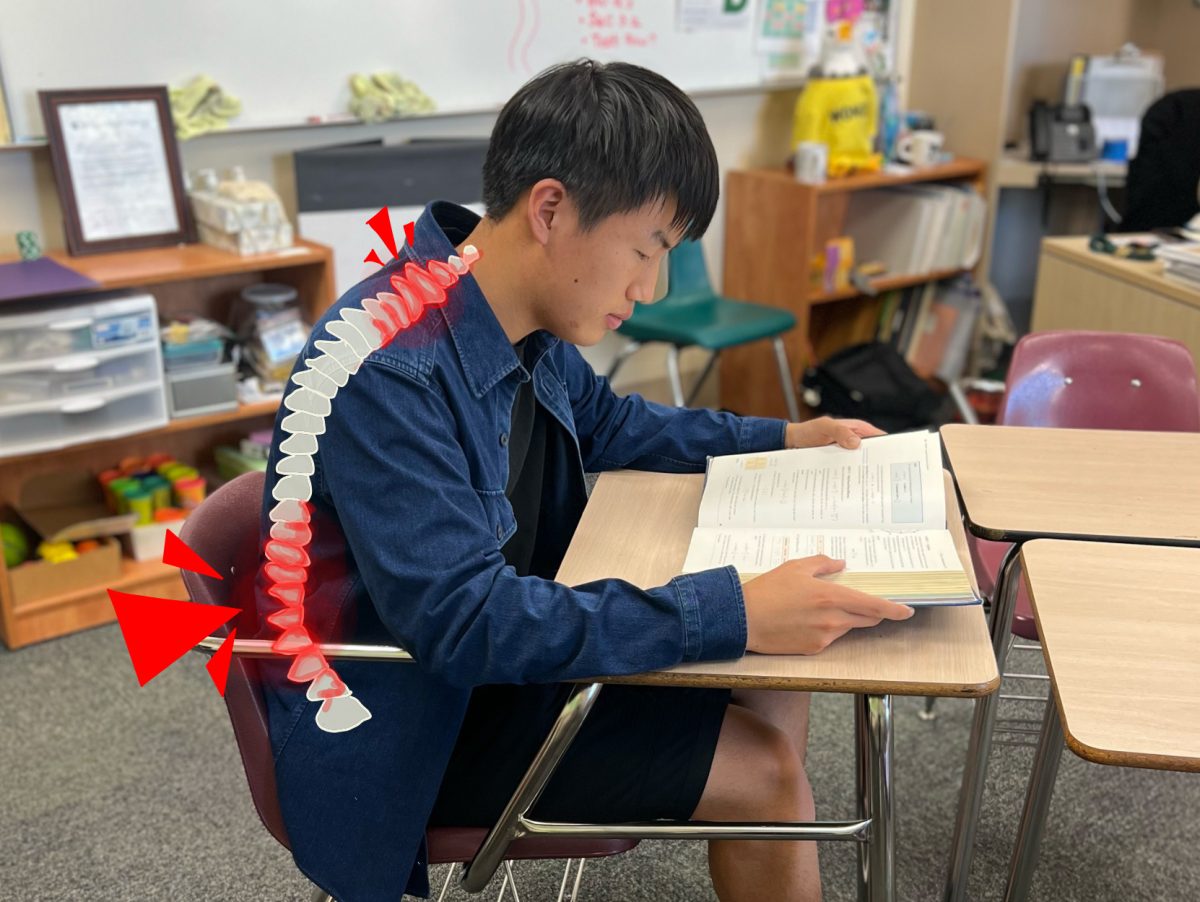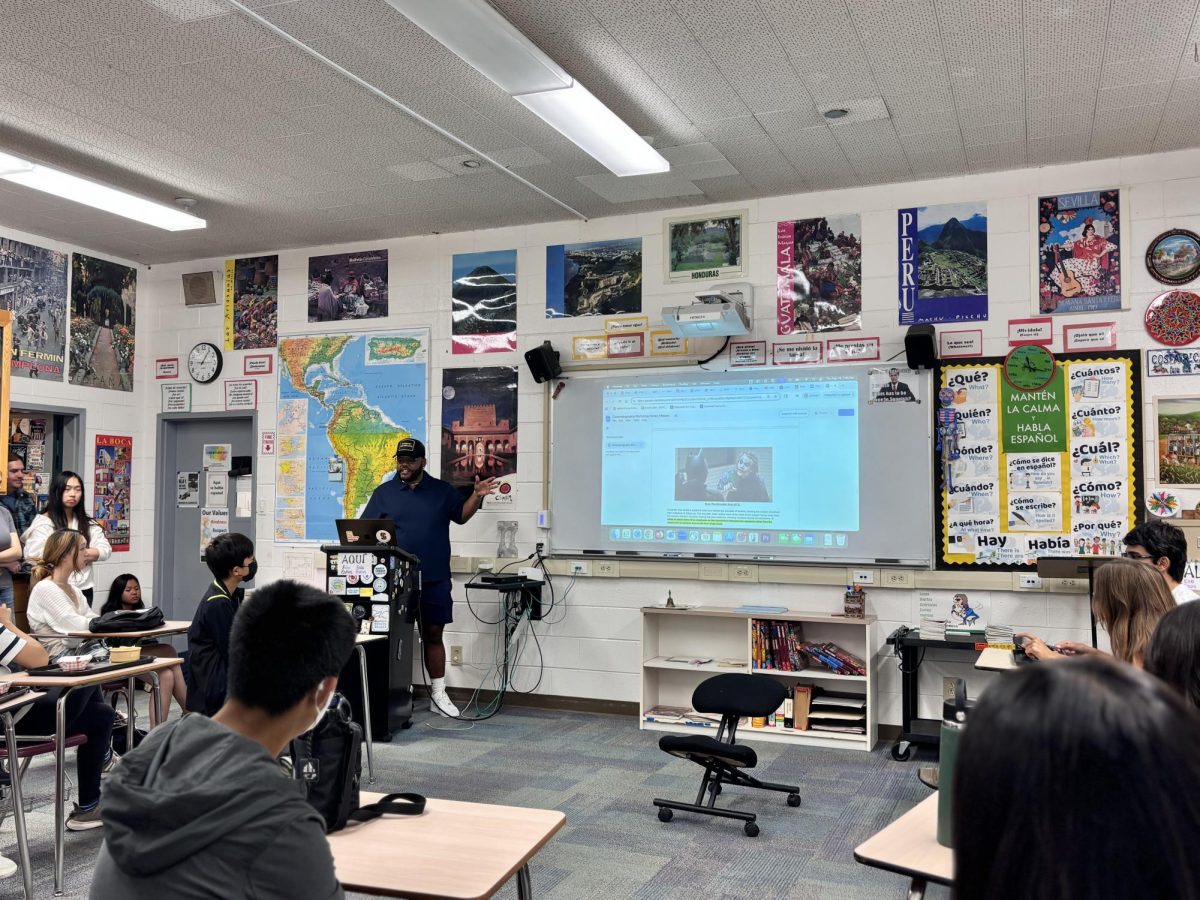Navigating through rows of desks, you gingerly squeeze through narrow gaps between chairs and backpacks and settle into your seat in the back of the classroom. The teacher turns on the projector, about to begin the lecture. But when you look up to copy the problems off the board, the tightly arranged tables make it difficult to see past your classmates.
Classroom layout may seem like a minor detail, but for many students, it is an essential part of learning. Whether it is desk arrangement or chair design, poor classroom set-ups can cause daily discomfort and obstruct learning.
“I sit at the very back of my math class, and my view of the board is often blocked by students in front of me,” Kaitlyn Nelson (10) said. “When we have lessons, I have to lean and move my body to see what is going on, which can get frustrating after some time.”
Improper posture at school increases students’ risk of more dangerous diseases, according to Hao Liu, who operates a Traditional Chinese Medicine private practice in Sunnyvale. In TCM, practitioners view back pain as the manifestation of bodily imbalances and emphasize combatting this problem through acupuncture, herbal medicine and massage to restore natural harmony.
During their teenage years, children undergo rapid bone growth. However, their muscles develop slower and often are not strong enough to support their skeletal structure. This imbalance leaves adolescents prone to poor posture, and exacerbates spinal disease.
“Everyday you spend so many hours in class,” Dr. Liu said. “If you are always twisted, sitting sideways, crossing your legs, your entire spine is twisted, and you will develop scoliosis on it. A lot of people with scoliosis gradually develop bad eyesight, hearing problems and balancing problems.”
Scoliosis, a spinal disorder characterized by a sideways curvature of the spine, affects 4% of adolescents, according to the Scoliosis Research Society. Dr. Liu notes that while treatment can quickly reverse damage in mild cases, scoliosis can develop into a chronic problem that leads to more health risks.
Junior Jaden Fu shared his thoughts on classroom setups, noting how current classroom arrangements impact his comfort during class.
“In the math classrooms, the chairs are connected to the desks,” Jaden said. “I like moving around a little bit. The desks are also really small and the chairs don’t give enough back support.”
Improving classroom layouts and furniture is the key to addressing these issues. Optimal arrangements and workstations can enhance student learning by increasing comfort and visibility. Senior Nolan Chen echoed Jaden’s preferences for large desk space, favoring the tables in Nichols.
“I like science classroom tables more than individual desks. It gives you more space to work with,” Nolan said. “Sometimes if your partner is absent you can steal even more space. It resembles my own workspace at home.”
Students can also make minor adjustments in seating habits to combat back pain and other physical discomforts. Dr. Liu recommends students focus on improving their posture individually to protect their spines.
“If you are lowering your head, your cervical spine needs to hold a lot more weight than it is designed to handle,” Dr. Liu said. “Instead, when you are looking down, tuck your chin in a little bit. You will feel your neck muscles getting stronger to hold your spine. You get support from your muscles, and the weight of your head is not only on your spine so it is more safe.”


















![“[Building nerf blasters] became this outlet of creativity for me that hasn't been matched by anything else. The process [of] making a build complete to your desire is such a painstakingly difficult process, but I've had to learn from [the skills needed from] soldering to proper painting. There's so many different options for everything, if you think about it, it exists. The best part is [that] if it doesn't exist, you can build it yourself," Ishaan Parate said.](https://harkeraquila.com/wp-content/uploads/2022/08/DSC_8149-900x604.jpg)




![“When I came into high school, I was ready to be a follower. But DECA was a game changer for me. It helped me overcome my fear of public speaking, and it's played such a major role in who I've become today. To be able to successfully lead a chapter of 150 students, an officer team and be one of the upperclassmen I once really admired is something I'm [really] proud of,” Anvitha Tummala ('21) said.](https://harkeraquila.com/wp-content/uploads/2021/07/Screen-Shot-2021-07-25-at-9.50.05-AM-900x594.png)







![“I think getting up in the morning and having a sense of purpose [is exciting]. I think without a certain amount of drive, life is kind of obsolete and mundane, and I think having that every single day is what makes each day unique and kind of makes life exciting,” Neymika Jain (12) said.](https://harkeraquila.com/wp-content/uploads/2017/06/Screen-Shot-2017-06-03-at-4.54.16-PM.png)








![“My slogan is ‘slow feet, don’t eat, and I’m hungry.’ You need to run fast to get where you are–you aren't going to get those championships if you aren't fast,” Angel Cervantes (12) said. “I want to do well in school on my tests and in track and win championships for my team. I live by that, [and] I can do that anywhere: in the classroom or on the field.”](https://harkeraquila.com/wp-content/uploads/2018/06/DSC5146-900x601.jpg)
![“[Volleyball has] taught me how to fall correctly, and another thing it taught is that you don’t have to be the best at something to be good at it. If you just hit the ball in a smart way, then it still scores points and you’re good at it. You could be a background player and still make a much bigger impact on the team than you would think,” Anya Gert (’20) said.](https://harkeraquila.com/wp-content/uploads/2020/06/AnnaGert_JinTuan_HoHPhotoEdited-600x900.jpeg)

![“I'm not nearly there yet, but [my confidence has] definitely been getting better since I was pretty shy and timid coming into Harker my freshman year. I know that there's a lot of people that are really confident in what they do, and I really admire them. Everyone's so driven and that has really pushed me to kind of try to find my own place in high school and be more confident,” Alyssa Huang (’20) said.](https://harkeraquila.com/wp-content/uploads/2020/06/AlyssaHuang_EmilyChen_HoHPhoto-900x749.jpeg)











